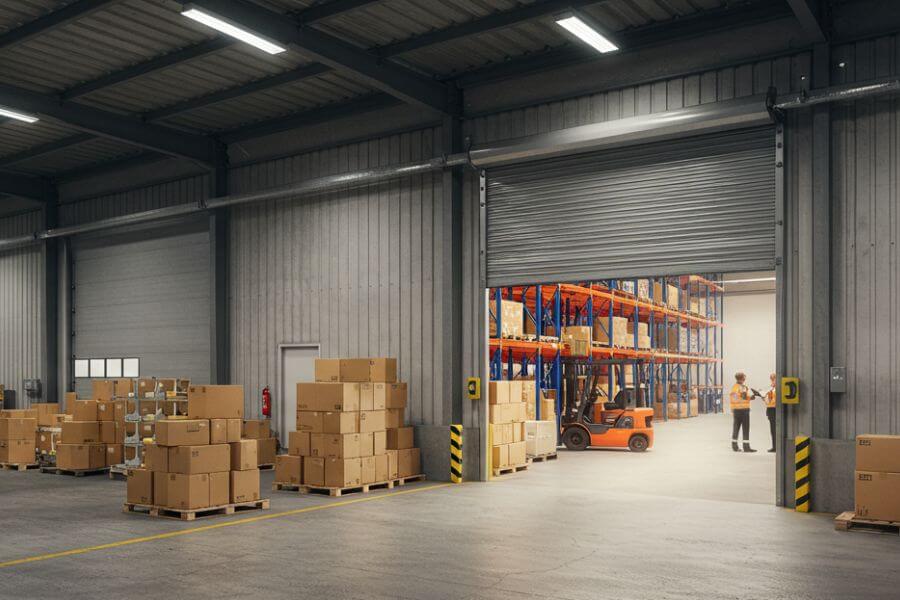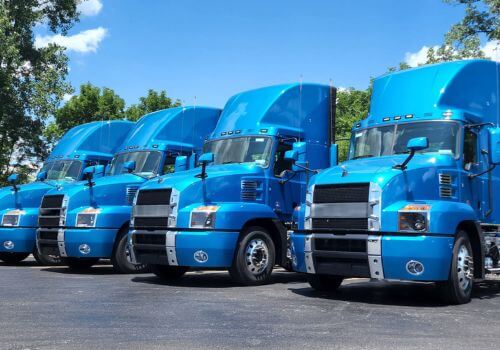In logistics, every minute counts, and the dock-to-stock process is one of the most crucial time-sensitive operations in warehouse management. Whether you’re managing a regional distribution center or a nationwide fulfillment network, the efficiency of your dock-to-stock cycle directly impacts inventory accuracy, labor productivity, space utilization, and customer satisfaction.
This in-depth guide explores what dock-to-stock really means, why it’s vital to modern supply chains, and how you can optimize this essential process for long-term efficiency and scalability.
What is dock-to-stock?
Dock-to-stock refers to the entire process of receiving incoming goods at a warehouse dock and moving them into their assigned storage locations. It begins the moment a shipment is unloaded from a trailer and ends when the items are fully integrated into the warehouse management system (WMS) and physically placed into inventory. This process includes verification, inspection, labeling, and putaway.
What makes dock-to-stock so critical is that it serves as the bridge between inbound logistics and internal warehouse operations. Before inventory can be used for production, fulfillment, or replenishment, it must be formally received and stored. A delay or error at this stage cascades through the supply chain, causing stock discrepancies, fulfillment errors, and operational slowdowns.
In many warehouses, dock-to-stock is used as a key performance indicator (KPI) to measure inbound efficiency. A streamlined process reflects well-coordinated systems, proper labor allocation, and optimized workflows, while delays often indicate bottlenecks in inspection, staffing, or layout design.
What is the importance of dock-to-stock in logistics?
Dock-to-stock is more than just a procedural task; it’s a strategic function with ripple effects throughout the supply chain. When goods are received and stored quickly and accurately, they become immediately available for customer orders, replenishment cycles, or manufacturing processes.
The benefits of an optimized dock-to-stock process include:
Faster inventory availability
The quicker items are put into stock, the sooner they can be used for order fulfillment. In high-volume fulfillment centers, even a one-hour delay can affect hundreds of customer orders. In industries like e-commerce or retail, where time-to-market is everything, dock-to-stock speed directly influences customer satisfaction and brand loyalty.
Increased warehouse throughput
When the dock-to-stock process runs smoothly, incoming goods don’t pile up at the receiving area. This clears dock space for additional shipments and prevents congestion that could slow down other operations like outbound loading or cross-docking.
Enhanced inventory accuracy
Accurate data entry, inspection, and labeling during dock-to-stock ensure that inventory counts in your WMS reflect reality. This is critical for avoiding overselling, managing stock levels, and providing real-time inventory visibility to sales and procurement teams.
Labor efficiency and cost reduction
Dock-to-stock can consume a significant portion of labor hours if not properly managed. Automating or streamlining this workflow reduces manual tasks, increases labor productivity, and lowers operational costs.
According to WERC’s benchmark study, high-performing warehouses achieve dock-to-stock times under 4 hours, while low-performing ones may take over 20 hours, resulting in labor inefficiencies, lost revenue, and poor space utilization.
What are the key stages of the dock-to-stock process?
While every warehouse is different, the dock-to-stock process generally follows a consistent workflow. Understanding each stage is essential for identifying points of delay or inefficiency.
1. Receiving and unloading
The process begins with the physical arrival of a shipment. Warehouse staff confirm the delivery schedule, verify documentation (such as the bill of lading), and inspect shipment condition before unloading begins. Depending on facility size and volume, unloading may involve manual labor, forklifts, pallet jacks, or automated conveyors.
Poor scheduling or unexpected arrivals can create bottlenecks at this stage. Advanced shipping notices (ASNs) and scheduled time slots are often used to prevent congestion and ensure teams are ready for incoming loads.
2. Inspection and quality control
After unloading, products must be inspected for quantity, condition, and accuracy. This step ensures that what’s received matches what was ordered and that there’s no damage, spoilage, or labeling issues. In regulated industries like pharmaceuticals or food logistics, inspection is even more rigorous and often documented for compliance purposes.
Items failing inspection are flagged and either quarantined, returned, or marked for further review. This prevents non-conforming items from entering usable inventory and reduces the risk of customer complaints or product recalls later on.
3. Data entry and labeling
Next, warehouse workers or systems input product information into the warehouse management system (WMS). This often includes SKU details, batch numbers, expiration dates, and quantity received. If items arrive unlabeled, staff apply barcode or RFID tags at this stage.
The accuracy of this step is critical; errors in data entry or labeling can lead to mis-picks, shipping mistakes, and inventory discrepancies. Automated barcode scanning and handheld devices are now standard tools for reducing human error and speeding up this process.
4. Putaway and inventory placement
Once verified and labeled, items are transported to their designated storage locations. This is called putaway. Storage types may include pallet racking, shelving, bins, or temperature-controlled zones, depending on the item.
Advanced WMS platforms often use rules-based logic to assign the best location for new inventory, optimizing space and retrieval efficiency. Proper putaway reduces retrieval time during order picking and prevents misplaced inventory that can disrupt fulfillment.
In high-performing operations, putaway happens within minutes of unloading, keeping the flow of goods seamless and continuous.
What are ways to optimize the dock-to-stock process?
Improving dock-to-stock is both an art and a science. It requires a balance of technology, workflow refinement, and workforce management. Here are proven strategies to increase speed and accuracy:
Implement a robust WMS
A warehouse management system is the backbone of dock-to-stock efficiency. It automates inventory updates, tracks inbound shipments, generates putaway instructions, and provides real-time analytics. With the right integrations, WMS platforms can also connect with transportation management systems (TMS) to manage ASNs and scheduling.
Adopt barcode and RFID technology
Barcodes and RFID tags dramatically reduce errors and improve speed. Scanning eliminates manual entry, enables real-time verification, and supports paperless operations. RFID technology can even track pallet movements without direct line-of-sight, ideal for high-volume facilities.
Schedule and prioritize deliveries
Use ASNs and delivery appointment systems to control the flow of inbound shipments. By spreading deliveries throughout the day and prioritizing time-sensitive goods, you reduce congestion and improve labor planning.
Redesign layout for flow efficiency
Analyze your warehouse layout and reconfigure it to minimize travel time from dock to storage. Use high-velocity zones for fast-moving SKUs, and consider cross-docking for items that don’t require long-term storage.
Standardize SOPs and checklists
Document standard operating procedures for receiving, inspecting, and putaway. Use digital checklists or mobile devices to ensure consistency and compliance. This reduces training time and helps onboard seasonal or temp staff more effectively.
Use labor planning tools
Track labor performance metrics and use forecasting tools to plan staffing levels based on delivery schedules. Cross-train employees to handle both receiving and putaway tasks, giving you more flexibility during peak times.
Dock-to-stock in key industries
Different industries have unique requirements when it comes to dock-to-stock. Here’s how it functions in a few common sectors:
E-commerce fulfillment
Speed is paramount in e-commerce. Orders are placed every minute, and inventory must be available immediately. Dock-to-stock processes are often automated with conveyors, robotic putaway systems, and integrated WMS platforms to meet high order volumes.
Automotive logistics
The just-in-time nature of automotive manufacturing requires rapid receiving and error-free putaway. Suppliers delivering parts must be processed within tight windows to avoid production downtime, making dock-to-stock precision essential.
Food and beverage warehousing
Time and temperature sensitivity make dock-to-stock efficiency crucial. Perishable goods must be moved to cold storage within minutes of unloading, requiring seamless coordination between receiving, inspection, and putaway teams.
Pharmaceutical supply chains
Pharma logistics require strict compliance with FDA regulations and traceability standards. Dock-to-stock processes include detailed documentation, temperature tracking, and chain-of-custody validation before storage in cleanrooms or secure vaults.
What is the role of 3PLs in dock-to-stock optimization?
Third-party logistics providers (3PLs) specialize in streamlining warehousing functions, and dock-to-stock is no exception. Partnering with a 3PL can provide access to:
- Automated receiving systems
- Sophisticated WMS platforms
- Trained warehouse personnel
- Flexible staffing and dock scheduling
- Optimized layouts for high-speed putaway
For example, a 3PL with facilities near the Port of Los Angeles can receive container shipments from Asia and move them into inventory the same day, supporting faster order processing for retailers across California. Similarly, a Midwest 3PL can offer 2-day fulfillment to 90% of U.S. customers while maintaining tight dock-to-stock KPIs due to central proximity and operational efficiency.
5 key metrics to track for dock-to-stock efficiency
Data-driven optimization is impossible without performance metrics. Here are the most important KPIs for evaluating your dock-to-stock process:
- Average dock-to-stock time: Total time from unloading to inventory placement
- Receiving accuracy rate: Percent of shipments received without errors
- Putaway accuracy rate: Percent of items stored in correct locations
- Labor cost per receipt: Total labor cost divided by the number of shipments received
- Dock utilization rate: Percentage of time each dock door is active
Monitoring these KPIs regularly allows you to spot trends, uncover inefficiencies, and measure the ROI of any process improvements.
Frequently asked questions about dock-to-stock
Q1. What’s a good benchmark for dock-to-stock time?
A1. Top-performing warehouses often complete the process in under 4 hours. However, it can vary based on item type, automation level, and facility size.
Q2. What tools help improve dock-to-stock performance?
A2. WMS software, barcode scanners, RFID, and dock scheduling systems are among the most effective tools for reducing errors and delays.
Q3. How does dock-to-stock affect order fulfillment?
A3. Faster dock-to-stock means inventory is ready for picking sooner, supporting faster order turnaround and more accurate delivery promises.
Q4. Can 3PL providers handle dock-to-stock for me?
A4. Yes. Most 3PLs offer end-to-end inbound logistics services, including receiving, inspection, labeling, and storage.
Q5. Is it possible to automate the dock-to-stock process completely?
A5. While full automation is costly, many elements like scanning, labeling, and routing can be partially or fully automated to improve performance.
In summary, Dock-to-Stock is the end-to-end logistics process that encompasses the receipt, inspection, documentation, labeling, and physical placement of inbound goods from the receiving dock into designated storage locations within a warehouse, enabling accurate inventory availability and seamless order fulfillment.







